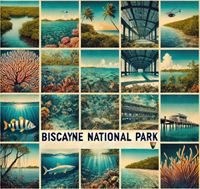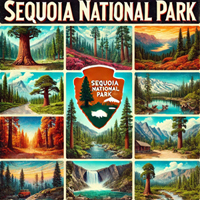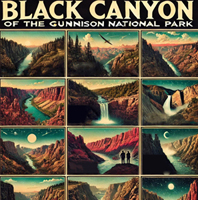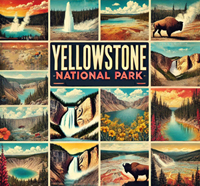

William and Hui Cha Stanek have meticulously crafted these national park guides, each showcasing the most stunning landscapes across the USA. But beyond the breathtaking scenery, these guides delve into the stories, experiences, and connections that make each park visit truly memorable.
National Parks Index | US Itineraries Index | American Roadtrips Index

Bring home a Bugville Critters book and watch as your child's love for reading and learning grows with every page. Hand-painted illustrations bring the heartwarming stories to life. Ask your librarian to add Bugville Critters to the library's digital collection today!
Discover William Stanek's Exclusive Art Collection
Explore and purchase the stunning art featured on this site. Own a piece of William Stanek's unique and captivating artwork today!
(April 20, 2025) Introducing Sequoia National Park: California's Giant Kingdom
Introduction to Sequoia National Park
Sequoia National Park is a place where you feel the true grandeur of nature, standing among the giants that have witnessed centuries of history. My first encounter with the General Sherman Tree, the largest tree on Earth by volume, was a moment of awe that I' ll never forget. Walking through the Giant Forest, where these massive trees reach towards the sky, I felt a deep sense of respect for the natural world. The sheer size of the sequoias, some over 2,000 years old, is humbling, and being in their presence is like stepping into a sacred space. One of my favorite hikes is the trek up to Moro Rock, where the panoramic views of the Sierra Nevada are simply breathtaking. Sequoia National Park is a place where the wonders of nature are on full display, offering a profound connection to the earth' s ancient history.
How to Reach Sequoia National Park
From the North (Fresno, CA): Travelers can take CA-99 south to CA-198 east, which leads directly into the park. The distance is approximately 75 miles, with a travel time of around 1.5 hours.
From the South (Los Angeles, CA): Visitors from Los Angeles can take Interstate 5 north to CA-99 north, then follow CA-198 east to the park. This route covers about 200 miles and takes around 4 hours.
From the East (Las Vegas, NV): From Las Vegas, take Interstate 15 south to CA-58 west, then follow CA-99 north to CA-198 east to the park. This journey spans approximately 330 miles and takes around 6 hours.
From the West (San Francisco, CA): Travelers from San Francisco can take Interstate 580 east to Interstate 5 south, then follow CA-99 south to CA-198 east to the park. This route covers approximately 270 miles and takes around 5 hours.
Exploring Sequoia: Must-Visit Sites
- General Sherman Tree: The largest tree on Earth by volume, located in the Giant Forest.
- Moro Rock: A granite dome offering panoramic views of the park.
- Crystal Cave: A marble cave featuring stunning formations, open for guided tours.
- Crescent Meadow: A picturesque meadow surrounded by giant sequoias, perfect for hiking and photography.
Seasonal Variations
Sequoia's diverse landscapes offer beauty year-round:
- Spring: Melting snow and blooming wildflowers create ideal conditions for exploration.
- Summer: Warm temperatures and clear skies provide excellent visibility and access to all park areas.
- Fall: Cooler temperatures and fewer visitors create a peaceful environment.
- Winter: Snow-covered landscapes offer a serene and stark contrast, ideal for solitude and photography.
Visitor Updates for Sequoia National Park
Conservation Efforts
William Stanek's photography in Sequoia emphasizes the park's ancient and majestic sequoia trees. His work highlights the importance of preserving these natural giants from the impacts of climate change, wildfires, and human activity, advocating for the protection of the park's unique ecosystems.
1 Day at Sequoia National Park: California's Land of Giants
Introduction
Sequoia National Park, located in the southern Sierra Nevada mountains of California, is known for its giant sequoias, rugged peaks, and diverse ecosystems. Here's a detailed guide to making the most of your visit, with expert tips from William and Hui Cha Stanek.
Morning: Sunrise and Scenic Drives
6:00 AM - Sunrise at Moro Rock
- Overview: Start your day with a breathtaking sunrise from the top of Moro Rock, offering stunning views of the park.
- Tips from William: Arrive early to set up your tripod and capture the sunrise. Use a wide-angle lens to encompass the entire scene.
- Insights from Hui Cha: Dress warmly and bring a thermos of hot coffee or tea. The early morning mountain air can be chilly.
7:30 AM - Breakfast at Wuksachi Lodge
- Overview: Head to Wuksachi Lodge for a quick breakfast with stunning views of the park.
- Tips from William: Capture the morning light on the surrounding peaks and the lodge's rustic architecture.
- Insights from Hui Cha: Enjoy a hearty breakfast to fuel your day. Grab some snacks and water for later.
Mid-Morning: Exploring Giant Sequoias
8:30 AM - General Sherman Tree
- Overview: Visit the General Sherman Tree, the largest tree on earth by volume.
- Tips from William: Use a wide-angle lens to capture the sheer size of the tree. The morning light is perfect for photography.
- Insights from Hui Cha: Wear comfortable shoes for the short walk to the tree. The trail is paved and accessible.
10:00 AM - Congress Trail
- Overview: Hike the Congress Trail, a 2-mile loop that passes through the heart of the Giant Forest.
- Tips from William: Use a wide-angle lens to capture the towering sequoias. The mid-morning light enhances the colors and textures.
- Insights from Hui Cha: The trail is relatively easy and offers beautiful views. Bring water and take breaks as needed.
Afternoon: Scenic Drives and Additional Sites
12:00 PM - Picnic Lunch at Crescent Meadow
- Overview: Enjoy a packed lunch at Crescent Meadow, known as the "Gem of the Sierra."
- Tips from William: Capture candid moments of your picnic with the beautiful meadow backdrop.
- Insights from Hui Cha: Pack a nutritious and energizing meal. Take a moment to relax and enjoy the natural surroundings.
1:30 PM - Tunnel Log
- Overview: Visit Tunnel Log, a fallen sequoia that was hollowed out to allow cars to pass through.
- Tips from William: Use a wide-angle lens to capture the unique feature. Experiment with different compositions and perspectives.
- Insights from Hui Cha: This is a great spot for some fun photos. The area can be crowded, so be patient and respectful of other visitors.
3:00 PM - Crystal Cave
- Overview: Take a guided tour of Crystal Cave, a marble cavern filled with stunning formations.
- Tips from William: Use a tripod and a camera with good low-light performance to capture the intricate formations. The tour provides dramatic photo opportunities.
- Insights from Hui Cha: Wear sturdy shoes and a light jacket. The cave can be cool, and the tour can be moderately strenuous.
Late Afternoon: Photography and Relaxation
4:30 PM - Giant Forest Museum
- Overview: Visit the Giant Forest Museum to learn more about the park's natural history and the giant sequoias.
- Tips from William: Capture the exhibits and the surrounding forest. Use a wide-angle lens for interior shots.
- Insights from Hui Cha: The museum offers fascinating insights into the park's past. Take your time exploring the exhibits.
Evening: Sunset and Dinner
6:00 PM - Sunset at Beetle Rock
- Overview: Head to Beetle Rock for a stunning sunset view over the Sierra Nevada.
- Tips from William: Use a graduated neutral density filter to balance the exposure. Experiment with long exposures to capture the changing light.
- Insights from Hui Cha: Arrive early to find a good spot. Bring a light jacket as it can get cool after sunset.
7:30 PM - Dinner in Three Rivers
- Overview: Return to the nearby town of Three Rivers for a relaxing dinner at a local restaurant.
- Tips from William: Capture the evening atmosphere of the small town. Try some local California cuisine to end your day.
- Insights from Hui Cha: Reflect on the day's adventures and enjoy a hearty meal. Three Rivers offers a variety of dining options with a welcoming atmosphere.
Sequoia National Park (California)
Sequoia National Park, located in the southern Sierra Nevada mountains of California, is famous for its giant sequoia trees, including the world's largest tree, General Sherman. Covering over 400,000 acres, the park features dramatic landscapes, diverse ecosystems, and rich biodiversity, offering a unique experience for nature lovers and photographers.
Park History and Cultural Significance:
- Established as a national park in 1890, Sequoia protects significant natural and cultural resources, including some of the world's largest trees.
- The area has a rich history of Native American habitation, particularly by the Yokuts and Mono tribes. The park also preserves sites related to early European explorers and settlers.
Visitor Centers and Facilities:
- Foothills Visitor Center: Offers exhibits on the park's natural and cultural history, a park film, maps, information, restrooms, and a gift shop.
- Giant Forest Museum: Provides exhibits on the giant sequoias, maps, information, and restrooms.
- Lodgepole Visitor Center: Offers exhibits, a park film, maps, information, restrooms, and a gift shop.
- Campgrounds: The park has several campgrounds, including Lodgepole, Dorst Creek, and Potwisha, offering basic amenities like restrooms and picnic tables.
Best Times to Visit:
- Spring (April to May): Ideal for moderate temperatures and fewer crowds.
- Summer (June to August): Warm weather perfect for exploring the giant sequoias, though it can be crowded.
- Fall (September to November): Cooler temperatures and fewer crowds make this a great time to visit.
- Winter (December to March): Offers solitude and opportunities for winter activities like snowshoeing and cross-country skiing, but temperatures can be cold, and access may be limited.
Activities and Recreation:
- Hiking: Trails range from easy walks to challenging hikes, including the Congress Trail, Moro Rock Trail, and the High Sierra Trail.
- Wildlife Watching: Opportunities to see black bears, mule deer, and a variety of bird species.
- Scenic Drives: The Generals Highway offers breathtaking views of the park's landscapes and access to many trailheads and viewpoints.
- Camping: Campgrounds provide opportunities for both frontcountry and backcountry camping.
- Photography: The park's giant sequoias and stunning landscapes provide endless opportunities for photography, particularly at sunrise and sunset.
- Winter Sports: Cross-country skiing and snowshoeing are popular activities during the winter months.
Accessibility Information:
- The Foothills Visitor Center, Giant Forest Museum, and Lodgepole Visitor Center are wheelchair accessible.
- Accessible trails include the Big Trees Trail and the General Sherman Tree Trail.
- Accessible campgrounds and restrooms are available throughout the park.
Permits and Regulations:
- Entrance Fees: Required for entry; passes can be purchased online or at park entrances.
- Camping Permits: Required for camping at designated campgrounds. Reservations are recommended during peak seasons.
- Backcountry Permits: Required for overnight stays in backcountry areas.
- Fishing Permits: Required for fishing in the park's lakes and rivers.
- Special Use Permits: Needed for activities such as weddings, commercial filming, and large group gatherings.
Nearby: Kings Canyon National Park, Giant Sequoia National Monument
-
Kings Canyon National Park: Adjacent to Sequoia, Kings Canyon features deep valleys, high cliffs, and the General Grant Tree.
- Activities: Hiking, camping, wildlife viewing.
- Notable Sites: General Grant Tree, Zumwalt Meadow.
- Wildlife: Black bears, mule deer, mountain lions.
-
Giant Sequoia National Monument: Also adjacent to Sequoia, this monument preserves more giant sequoia groves and offers hiking and scenic drives.
- Activities: Hiking, scenic driving, wildlife viewing.
- Notable Sites: Trail of 100 Giants, Boole Tree.
- Wildlife: Black bears, mule deer, various bird species.
Important Updates for Sequoia National Park
Sequoia National Park (California)
Sequoia National Park, located in California's Sierra Nevada mountains, is renowned for its giant sequoia trees, rugged mountain terrain, and stunning natural beauty. The park is home to the General Sherman Tree, the largest tree on Earth by volume, and offers a variety of outdoor activities and breathtaking landscapes. Renowned photographers William and Hui Cha Stanek have captured the park's awe-inspiring beauty through their lenses. This guide explores local attractions, nearby towns and cities, scenic drives, and the best hikes in and around Sequoia National Park, enriched by the Staneks' expertise and experiences.
The nearby town of Three Rivers serves as the primary gateway to the park, providing a variety of amenities including lodging, dining, and shops. Three Rivers is home to the Sequoia Foothills Chamber of Commerce, which offers information and resources for visitors. Further afield, the city of Visalia offers additional amenities and attractions, including the ImagineU Children's Museum, the Visalia Fox Theatre, and the historic downtown area. Visalia also serves as a gateway to the nearby Kings Canyon National Park, which offers additional opportunities for hiking, wildlife viewing, and exploring the region's stunning landscapes.
Local Attractions and Surrounding Areas
Sequoia National Park is surrounded by numerous attractions that enhance the visitor experience. Here are some must-see local attractions:
- General Sherman Tree: The largest tree on Earth by volume, located in the Giant Forest. It's a must-see attraction with a short, accessible trail leading to the tree.
- Moro Rock: A large granite dome offering panoramic views of the park. A steep stairway leads to the summit, providing breathtaking vistas.
- Crescent Meadow: A beautiful meadow surrounded by giant sequoias, often referred to as the "Gem of the Sierra." The area offers several easy hiking trails.
- Tunnel Log: A fallen giant sequoia that has been hollowed out to create a drive-through tunnel, a popular photo spot.
- Crystal Cave: An impressive marble cave with guided tours available from late spring to early fall. The cave features stunning formations and underground streams.
- Tokopah Falls: A picturesque waterfall reached by a moderately easy hike along the Marble Fork of the Kaweah River.
Nearby Towns and Cities
Visitors to Sequoia National Park can find additional amenities and activities in nearby towns and cities:
- Three Rivers, California: The closest town to the park's entrance, offering accommodations, dining options, and outdoor activities such as river rafting and fishing.
- Visalia, California: Located about 30 miles west of the park, Visalia offers extensive amenities, including hotels, restaurants, shopping, and attractions such as the Visalia Fox Theatre and Mooney Grove Park.
- Fresno, California: About 75 miles northwest of the park, Fresno offers a wide range of amenities, including hotels, restaurants, shopping, and attractions such as the Fresno Chaffee Zoo and the Forestiere Underground Gardens.
- Exeter, California: A small town located about 25 miles southwest of the park, offering accommodations, dining, and attractions such as the Exeter Murals and local shops.
- Lemon Cove, California: A small community located near the park's entrance, offering lodging and dining options.
Scenic Drives
Sequoia National Park offers several scenic drives that provide beautiful views of the park's landscapes. These drives are perfect for capturing the essence of the park through photography.
-
Generals Highway:
- Details: This 32-mile road connects Sequoia National Park with Kings Canyon National Park, offering stunning views of the Sierra Nevada mountains and access to many of the park's main attractions.
- Key Stops: Highlights include the Foothills Visitor Center, the General Sherman Tree, Moro Rock, Crescent Meadow, and Tunnel Log.
- Photography Tips: William Stanek suggests stopping at the various pull-offs and viewpoints to capture the changing landscapes and iconic sequoias. Early morning and late afternoon provide the best lighting for photography.
-
Moro Rock/Crescent Meadow Road:
- Details: This 3-mile road leads to Moro Rock, Tunnel Log, and Crescent Meadow, offering access to several scenic spots.
- Key Stops: Highlights include the Moro Rock parking area, Tunnel Log, and Crescent Meadow.
- Photography Tips: Hui Cha Stanek recommends using a wide-angle lens to capture the expansive views from Moro Rock and the serene beauty of Crescent Meadow. Early morning and late afternoon provide the best light for photography.
-
Mineral King Road:
- Details: This 25-mile narrow, winding road offers stunning views of the Mineral King Valley and access to high-altitude hiking trails. Note that the road is typically open from late May to October, weather permitting.
- Key Stops: Highlights include the Atwell Mill Campground, the Mineral King Ranger Station, and the Eagle/Mosquito Lakes Trailhead.
- Photography Tips: The Staneks suggest using a wide-angle lens to capture the valley views and a polarizing filter to enhance colors. The best times for photography are during the golden hours of sunrise and sunset.
-
Big Stump Basin Road:
- Details: Located in Kings Canyon National Park, this short road provides access to the Big Stump Basin, where visitors can see the remnants of logged giant sequoias.
- Key Stops: Highlights include the Mark Twain Stump and the trailhead for the Big Stump Basin Trail.
- Photography Tips: William Stanek recommends using a wide-angle lens to capture the massive stumps and a macro lens for details. Early morning and late afternoon provide the best light for photography.
Reservations and Timed Entry Information
Click the link to see updates. Wait up to 30 seconds for results.
Best Hikes
Sequoia National Park offers a variety of hiking trails that cater to all skill levels. Each trail provides unique opportunities for exploration and photography. Here are some of the best hikes in the park for prepared hikers:
-
Congress Trail:
- Details: This 2-mile loop trail starts at the General Sherman Tree and winds through the Giant Forest, passing by some of the largest trees in the park. The trail is moderately easy.
- Key Viewpoints: Highlights include the President Tree, the Senate Group, and the House Group.
- Photography Tips: William Stanek recommends visiting early in the morning to capture the best light and avoid crowds. A wide-angle lens is ideal for capturing the towering trees.
-
Moro Rock Trail:
- Details: This 0.5-mile round-trip trail involves a steep climb up a granite dome, offering panoramic views of the Sierra Nevada mountains. The trail is moderately strenuous.
- Key Viewpoints: Highlights include the views from the top of Moro Rock, including the Great Western Divide and the surrounding peaks.
- Photography Tips: Hui Cha Stanek suggests using a wide-angle lens to capture the expansive views from the summit. Early morning and late afternoon provide the best light for photography.
-
Tokopah Falls Trail:
- Details: This 4-mile round-trip trail follows the Marble Fork of the Kaweah River to Tokopah Falls, a beautiful waterfall surrounded by granite cliffs. The trail is moderately easy.
- Key Viewpoints: Highlights include the views of the river, the falls, and the surrounding cliffs.
- Photography Tips: The Staneks recommend using a polarizing filter to enhance the colors of the river and falls. Early morning and late afternoon provide the best light for photography.
-
Crescent Meadow Loop:
- Details: This 1.6-mile loop trail offers a scenic walk around Crescent Meadow, often referred to as the "Gem of the Sierra." The trail is easy and family-friendly.
- Key Viewpoints: Highlights include views of the meadow, Tharp's Log, and the Chimney Tree.
- Photography Tips: William Stanek suggests using a wide-angle lens to capture the meadow and a macro lens for details of the wildflowers and trees. Early morning and late afternoon provide the best light for photography.
-
High Sierra Trail to Bearpaw Meadow:
- Details: This 11.4-mile round-trip trail offers a challenging hike through diverse landscapes, including forests, meadows, and granite cliffs. The trail is strenuous.
- Key Viewpoints: Highlights include views of the Great Western Divide, Buck Canyon, and Bearpaw Meadow.
- Photography Tips: Hui Cha Stanek recommends using a wide-angle lens to capture the diverse landscapes and a telephoto lens for distant mountains. Early morning and late afternoon provide the best light for photography.
-
Big Trees Trail:
- Details: This 1.3-mile loop trail offers an easy walk around Round Meadow, with interpretive signs about the giant sequoias and their ecosystem. The trail is accessible and family-friendly.
- Key Viewpoints: Highlights include views of Round Meadow and the surrounding giant sequoias.
- Photography Tips: The Staneks suggest using a wide-angle lens to capture the meadow and trees and a polarizing filter to enhance colors. Early morning and late afternoon provide the best light for photography.
-
Marble Falls Trail:
- Details: This 7.4-mile round-trip trail offers a moderately strenuous hike along the Marble Fork of the Kaweah River to Marble Falls. The trail features diverse plant life and stunning views of the river.
- Key Viewpoints: Highlights include the views of the river, the falls, and the surrounding cliffs.
- Photography Tips: William Stanek recommends using a polarizing filter to enhance the colors of the river and falls. Early morning and late afternoon provide the best light for photography.
Other Hikes:
-
Lakes Trail to Pear Lake: This challenging 12-mile round trip hike takes hikers through the scenic Tokopah Valley to the stunning Pear Lake, offering beautiful views of the valley, the surrounding peaks, and the alpine lakes. The trail features steep climbs, rugged terrain, and stunning vistas. Key points of interest along the trail include the Heather Lake, the Emerald Lake, and the Pear Lake. William suggests this hike for experienced hikers looking for a rewarding adventure and breathtaking views.
-
Alta Peak Trail: This strenuous 14-mile round trip hike takes hikers to the summit of Alta Peak, offering panoramic views of the Great Western Divide, the Kaweah Peaks, and the surrounding valleys. The trail features steep climbs, stunning vistas, and diverse vegetation. Key points of interest along the trail include the Panther Gap, the Alta Meadow, and the Alta Peak summit. Hui Cha highlights this hike for experienced hikers looking for a challenging adventure and stunning views.
William and Hui Cha Stanek's extensive body of work at Sequoia National Park showcases their deep appreciation for its majestic trees, rugged landscapes, and diverse ecosystems. William's technical expertise with photographic equipment and Hui Cha's creative vision result in compelling images that highlight the park's giant sequoias, stunning vistas, and vibrant wildlife. Their dedication often involves waiting for hours to capture the perfect light and conditions, revealing the park's essence in each shot.
Conservation is a core theme in their photography. Through their stunning visual storytelling, they aim to foster a greater awareness of the need to protect natural landscapes like Sequoia National Park. Their support for organizations such as the National Park Foundation and the Sierra Club underscores their commitment to environmental stewardship and responsible tourism.
Conclusion
Sequoia National Park, with its towering sequoia trees, rugged mountain landscapes, and diverse ecosystems, offers endless opportunities for exploration and photography. The park's local attractions, scenic drives, and hiking trails provide a comprehensive experience for visitors. Through the lens of William and Hui Cha Stanek, the park's natural wonders and significance are vividly captured, inspiring a deeper appreciation and commitment to preserving this unique national treasure. Whether you're a seasoned photographer or a casual explorer, Sequoia National Park promises a memorable and enriching adventure.

Step into a world of timeless beauty with our premium, oversized hardcover book - crafted for discerning collectors and anyone who values the power of art. Perfect for your coffee table, it's more than just a book; it's a conversation starter, a window into over 30 years of William's visionary photography.
Your Support Matters
Purchasing artwork from William Stanek's collection not only brings beauty into your life but also helps us continue to share. Thank you for supporting our creative journey!

Support The Lights of Paris by Robert Stanek, William Stanek's pen name! Through vivid historical detail and deeply moving character stories, Robert takes readers on an unforgettable journey through one of history’s most transformative times.













